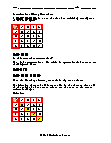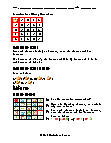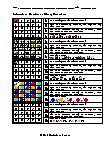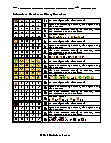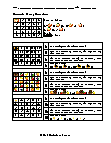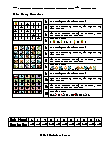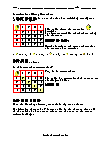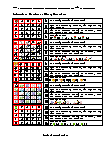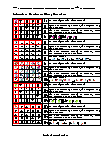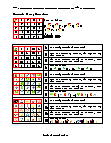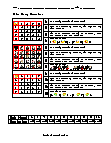Binary Operations Worksheets
What Are Binary Operations? Just as you obtain a number when you add, subtract, multiply, or divide the two numbers, the binary operations are related to the elements of a set. As the name suggests, binary operations consider any two parts of a set and the resultant of those elements is present in the same set. Binary operations are based on the two elements, the operands, to generate another element of the same set. Binary Addition - It works like the base 10 decimal system, only that the base is 2 in binary addition. The binary system has only two digits, 1 and 0. All binary operations are based on these two digits. Before doing the binary addition, one should know the basic rules and knowledge of the process. Here we have discussed the four rules of binary addition: 0 + 0 = 0 , 0 +1 = 1 , 1 + 0 = 1, 1 + 1 = 10. Binary Subtraction - Like binary addition, binary subtraction is similar to 10 base decimal system, but the base is 2. Here we have discussed the four rules of binary subtraction: 1 – 1= 0, 1 – 0 = 1, 0 – 1 = 1 (with a borrow of 1), 0 – 0 = 0. Binary Multiplication - Binary multiplication is the process of addition and shifting operation; the process continues until you are done with all multiplier to make an addition operation in the end. The rules of binary multiplication are as follows: 0 x 0 = 0, 0 x 1 = 0, 1 x 0 = 0, 1 x 1 = 1. Binary Division - Again, the binary division is similar to that of 10 decimal base system only with base 2. Unlike decimal division, binary division is easier if you remember the following rules: 1 ÷ 0 = 0, 1 ÷ 1 = 1 , 0 ÷ 1 = meaningless, 0 ÷ 0 = meaningless.
-
Basic Lesson
Demonstrates how to follow a binary operation rule set. A binary operation is a set of rules for combining two objects of the same type. Is this operation commutative? Yes, it is commutative. The table is symmetric with respect to the diagonal line.
View worksheet -
Intermediate Lesson
Explores how to use binary rule sets to answer logic questions. For each element having an inverse, name the element and its inverse. The inverse of A is A; the inverse of B is B; inverse of C is D and inverse of D is C.
View worksheet -
Independent Practice 1
Contains 20 Binary Operations problems. The answers can be found below.Name the identity element, or explain why none exists.
View worksheet -
Independent Practice 2
Features another 20 Binary Operations problems. For each element having an inverse, name the element and its inverse.
View worksheet -
Homework Worksheet
Binary Operations problems for students to work on at home. Example problems are provided and explained./p> View worksheet
-
Basic Lesson
Demonstrates how to read and use a binary table. Practice problems are provided. This table shows the operation (apple). It shows 16 possible calculations using the elements. Reading the table. Match the column and rows to determine the outcome.
View worksheet -
Intermediate Lesson
Explains how to interpret inverse binary operations. Practice problems are provided. Determine whether the operation is true or false.
View worksheet -
Independent Practice 1
Another series of exercises to work on this skill. The answers can be found below.
View worksheet -
Homework Worksheet
A great set to serve as work for home. Example problems are provided and explained./p> View worksheet
How Do You Solve Binary Operations?
You are learning arithmetic operations all your life. Starting from addition and subtraction towards dealing with the complexities of multiplication and division, you know everything regarding them. However, all of these operations have one thing in common, that they are only possible between two operands. In other words, you need entities before and after the operator for the operation to work. For instance, let us take an example; we need to perform multiplication between 8 and 3. It's simple, and the answer is 24. Moreover, if you are given an expression such as 3a+b, then a and b are the real numbers. Now, you must find out the expression’s nature in terms of the commutative and associative property. In this example, let us take a and b as 2 and 3, respectively. While for the second example, let us take the c value to be 4. Now, let us look at the following table.
| Properties | Explanation |
| 3a + b = 3b + a | 3 × 2 + 3 = 3 × 3 + 2<br> 6 + 3 = 9 + 2<br> 9 ≠ 11 <br> Not true for all real numbers. |
| 3a + (3b + c) = 3(3a + b) + c | 3×2 + (3×3 + 4) = 3(3×2 + 3) + 4<br> 6 + (9 + 4) = 3(6 + 3) + 4<br> 6 + (13) = 3(9) + 4<br> 19 = 31<br> Not true for all real numbers. |
Math and Crime
A man was arrested today trying to board a flight while in possession of a compass, a protractor and a calculator. According to law enforcement officials, he is member of the Al-Gebra network. He will be charged with carrying weapons of math instruction.
Geometry Chants
There's an old MIT football cheer: E to the x, dy, dx,... E to the x, dx... Secant, tangent, cosine, sine,... 3.14159... Square root, cube root, log base e,... Cheers for math at MIT.
